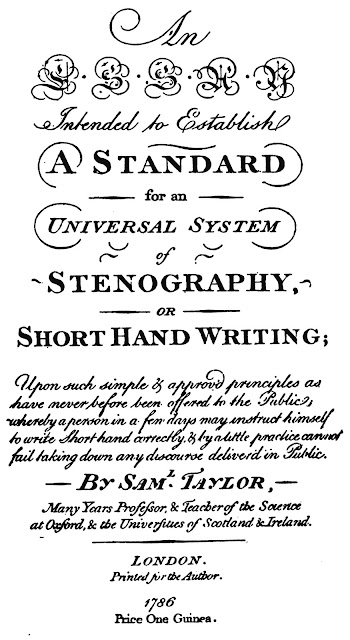Not much is known about the life of Samuel Taylor (1749—1811). His contemporaries were practically silent on his life, character, and work. And what we do know about Samuel Taylor mainly comes from his Stenography (1786), his book on fishing (Angling In All Its Branches, 1800), and a brief obituary published in the London Sun (1811).
Samuel Taylor was most likely born in 1749. A good part of his boyhood was spent in and about Shrewsbury, a town along the River Severn in Shropshire County. Between boyhood and about 1781, we only know Taylor’s shorthand system was the "result of many years application and practice."
Taylor began by desiring to master the best shorthand system. Not satisfied with any of them, he decides to develop his own system based on “more rational principles.” He examines more than forty works on shorthand, and just before he puts his new system into practice Taylor comes across an influential shorthand manuscript. The manuscript, without a doubt from shorthand experts, is the first edition of William Williamson Stenography published in 1775.
After examining Williamson’s Stenography, Taylor realizes his alphabet is wrong, forms a new alphabet, and improves the system—probably incorporating Williamson’s improvements—before sharing it with “the Public.”
How does Samuel Taylor share his new system? He goes on a fishing trip. Taylor combined business with pleasure in 1781 and 1782 when he took a fishing trip, “a tour to North Britain and Ireland.” As he travelled to the north of England, then to Scotland, and later to Ireland, Taylor fished, taught shorthand, and gathered testimonials.
Taylor’s book, An Essay Intended to Establish A Standard for an Universal System of Stenography, rapidly acquired popularity and was used extensively for the next sixty years. Not only was it an exceptional shorthand system but it had already taken root by years of teaching at Oxford and throughout the United Kingdom.
Samuel Taylor died in Westminster, London, and was buried in St. Margaret’s chapel yard, Westminster, on August 10, 1811.
An Essay Intended to Establish A Standard for an Universal System of Stenography (1786):
Sir Isaac Pitman stated “[Taylor’s] system is at least equal to Byrom’s in brevity, while it is simpler in its construction.” Taylor's system is based on William Williamson 1775 Stenography and Williamson’s system was founded on Byrom’s.
The Alphabet:
D, F/V, G/J, T and CH are written downwards. S and K/Q are written left to right. The loop for a looped sign may be written on either side to facilitate joining, but always written on the same end of the alphabet sign.
Vowels:
Taylor’s system has very limited vowel expression. Medial vowels were not expressed and only strong sounding and the beginning and ending of a word were expressed by a dot:
"A dot, thus (.) being the most simple mark that can be made, it is here appointed the representative of all the vowels, which are always omitted in the middle of a word, as also at the beginning or end, when they are silent, as then the consonants alone will sufficiently convey the sound of such words; but when a vowel sounds strong before or after any word, it is proper to express it by a dot, to denote that the word begins or ends with a vowel of a forcible sound."Taylor took great care so that loops might be written on either side of his looped alphabet signs. This increases the speed at which his system might be written because joining by a loop is generally a more effective way of saving time than to join by an angle. Stenography contains two tables of how to properly join the various alphabet signs.
William Harding brought out an adaptation of Taylor’s system in 1823, Universal Stenography. In Harding adaption, like most Taylor adaptations, means are provided for the distinction of the vowels. Harding wrote the vowels using a dot in three vertical positions representing a, e, i, and a dash in two vertical positions representing o, u.
References:
1. Dictionary of National Biography. 2nd Edition. Vol 19, 464-5 (1908-1909)
2. Butler, Edward. The Story of British Shorthand. 1951. Pgs 70-73.
3. Wright, Alexander. Samuel Taylor, Angler and Stenographer: Vol. 1. Willis-Byrom Club. 1904.
4. Taylor, Samuel. An Essay Intended to Establish A Standard for an Universal System of Stenography. 1786.



